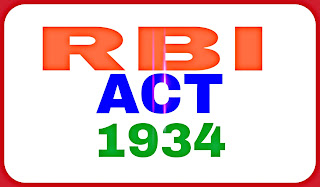RBI ACT, 1934
Reserve bank of India was formed under
the reserve bank of India act 1934.the RBI act was enacted on 06.03.1934 and
came into force on 01 April 1935. The RBI act extends to whole of India. The
act contained the definition of scheduled banks which are mentioned in second
schedule of RBI act.
the reserve bank of India act 1934.the RBI act was enacted on 06.03.1934 and
came into force on 01 April 1935. The RBI act extends to whole of India. The
act contained the definition of scheduled banks which are mentioned in second
schedule of RBI act.
 |
| RBI ACT |
Some important sections of RBI act for
promotion exams are explained briefly below
- Section 4:
It lays down that the capital of RBI shall be Rs. 5.00 crores. - Section 17: It lays down the type of business which the
bank may transact. It defines
manner in which the RBI can conduct business. The Reserve bank of India can
accept deposits from the central and state governments without interest. RBI
can purchase and discount bills of exchange from
commercial banks. It can purchase forex (foreign exchange) from banks
and sell it to them. It can provide loans to banks and state financial
corporations. It can provide advances to the government of India and state governments.
It can buy or sell government securities.
It can deal in derivatives, repo and
reverse repo. - Section 18:
It deals with emergency loans to banks. - Section 20:
It lays down the obligation of RBI to transact government business. - Section 21:
It gives RBI the right to transact government business in India. - Section 21A: Under this RBI can transact government business of states on agreement.
- Section 22:
Right to issue bank notes to RBI. RBI can issue notes of denomination 2 to
10000. One rupee note is issued by government of India under signature of
finance secretary. - Section 26:
Describes the legal tender character of bank notes. - Section 27:
It lays down that RBI shall not issue notes that are torn, defaced or
excessively spoiled. - Section
28: Allows RBI to frames rules regarding the exchange of damaged notes. - Section
29: Exempts RBI from stamp duty on bank notes. - Section
31: Says that in India only
the RBI or the central government can issue and accept promissory notes that
are payable on demand. However, cheques, that are payable on demand, can be
issued by anyone. - Section 33: Lays down that assets of
the issue department of RBI shall consist of gold coin, gold bullion, foreign
securities, rupee coins and rupee securities. - Section 42: Deals with cash reserve of
the scheduled banks. It says that every scheduled bank must have an average daily
balance with the RBI. The amount of the deposit should be more that a certain percentage of its net time and demand liabilities in India. No
interest is paid by RBI to banks on deposits under CRR (Cash Reserve Ratio).
x